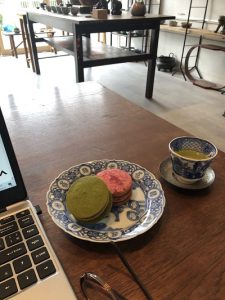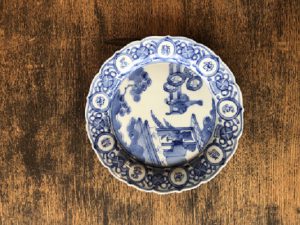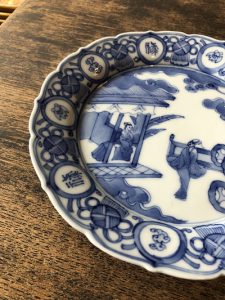バターチーズサンドと共に瀬戸焼について復習しております。(愛知県名古屋市千種区姫池通 古美術買取いたします 古美術風光舎名古屋店)
2022.03.17
こんにちは、スタッフYでございます。
本日はですね、先日店主からホワイトデーのお返しをいただきまして、名古屋ではまだ手に入らないバターチーズサンドをお昼休憩にいただいております。(今年もありがとうございます。いただきまーす。)

でですね大変美味しかったので、これは大切に一日一個ずつにしようと決めておくことに致しましたが、そんなバターサンド、せっかくですしお茶休憩に頂き写真撮影しようと、撮影用に2個モデルさんに登場してもらいました。そこで、彼?彼女?達に似合う瀬戸焼の平皿にて撮影を致しました。
こちらのお皿明治期の瀬戸焼でして、爽やかな染付の絵柄がなんとも繊細。どんな食材を乗せても清潔感ある盛り付けになりそうですね。
先日の萬古焼ではいですが、愛知県に住んで気づいたのですが、瀬戸焼といい、常滑焼といい、織部焼といい、焼き物の産地が愛知県や近県にまま存在することがわかります。
ですが、私の勉強不足。そうえば瀬戸焼の特徴をあまり知らないことに今更気づきましたよ。「せともの」とはよく申しますが、その「せともの」って、いったい…

ご存じの通り、瀬戸焼は、「せともの」を担う世界屈指の産地、愛知県瀬戸市周辺で作られている陶磁器の総称でもあります。瀬戸の地域でやきもの作りが始まったのは鎌倉時代でして、なぜこの地域というと、やはりやきものの原料になる良質な粘土(木節粘土・蛙目粘土)を採取することができ、環境に恵まれていたのはというのは、言うまでもありませんね。
ですが、焼き物の歴史において、先日の萬古焼など後継者や何らかの理由で途中で歴史が途切れる焼き物もある中、ここ瀬戸は約1000年もの間一度も途切れずにやきもの生産を続けてきております。受け継がれいる歴史をもっても、「せともの」が確固たる名称を確立し得てきた理由が納得できます。
日本の陶磁器窯には皆さまもご存じの通り、中世から現在までの長い期間生産が継続している代表的な6つの産地(越前・瀬戸・常滑・信楽・丹波・備前)があり、それらを総じて「日本六古窯(にほんろっこよう)」と呼ぶのですが、瀬戸焼もそのひとつ。世界的にも稀少な産地として知られており、またその名前の由来ですが、古来人々は陶器を作る地域を「陶所(すえと)」と呼んでいたようでして、陶所という言葉が転じて「瀬戸」の地名になったというユニークな説もあるようです。瀬戸がいかにその当時から焼き物の要所だったかというのが想像させられますね。
そして、瀬戸焼の手法ですが、陶器の種類では日本ではじめて釉薬(ゆうやく:うわぐすり)を施して焼かれた陶器として有名でして、まさに焼き物界の先駆者といったところでしょうか。
さて瀬戸焼の源ですが、古墳時代後期から鎌倉時代初期にかけて現在の愛知県名古屋市域で稼働していた「猿投窯(さなげよう:陶磁器を焼くために用いられた窯の遺構、古窯跡)」の流れをくんでいる陶磁器のようです。起源は、この地域で5世紀前半に須恵器(すえき)が生産されたことからはじまり、その後、古代から中世にかけて、名古屋市東部の約20km四方にわたり 1,000基をこえる数多くの瀬戸焼の窯がつくられていたようです。
この窯跡が猿投窯でして、正式名称を「猿投山西南麓古窯跡群(さなげやませいなんろくこようせきぐん)」といい、ここから瀬戸焼や常滑焼にへ広がったと言われております。
そんな古窯跡、なんと古美術風光舎のご近所にございます東山植物園にて(1972年(昭和47)に発掘された鎌倉時代初期の「登り窯」)見学することもできます。私は以前何も知らずに通り過ぎてしまい、こちらも復習を兼ねてまた訪れなければと思っております。ご興味のございます方は是非行かれてみてはいかがでしょうか。
そして鎌倉時代からの釉薬を施した瀬戸焼(古瀬戸)は、当時の庶民には縁遠い高級品として扱われますが、室町時代中期から生産地が岐阜県美濃地域に移ると、従来の穴窯から大窯へと生産方法が変わり、椀・小皿類、調理具などの日常的に使う製品が中心となり、瀬戸焼の大量生産が始まることになります。
先ほど出ました「古瀬戸」という名称ですが、こちらは室町時代までに作られたもののことを「古瀬戸」と呼びます。そして、その頃に陶磁器の生産拠点が岐阜県の美濃地方に移ったことから、美濃焼も瀬戸焼の流れをくむ陶器として知られることになるようです。確かに、訪れるとわかるのですが、瀬戸から美濃にかけては、どこまでが瀬戸か美濃か焼き物の里としてはもはや線引きは難しい一帯が焼き物の里といった地域ですよね。
さらに江戸時代になりますと、伝統的な陶磁器の生産は減少していき、御室茶碗や腰錆茶碗などが登場。各村で器種別の分業化をし、日用品が量産され、江戸時代後期から磁器生産がスタートします。すると、これまで主流だった陶器は「本業焼」、新たに導入した磁器は「染付焼」または「新製焼」と呼ばれるようになり、瀬戸焼は、陶器、磁器どちらの顔を持つことになるのですね。そういえば、本日使用したお皿も染付焼であります。なるほど。

そして、明治時代になると瀬戸窯業の基盤となる動力機械の導入により、インフラが整ってきます。ロクロは機械でおこない、模様は手書きではなく転写に。窯は石炭や重油を使用したものになり、いよいよ瀬戸焼の陶磁器は大量生産の時代に。お皿、マグカップなどの食器、の他、洗面台、便器、浴槽なども生活全般を支える陶磁器となっていったようですね。
とまあ、みんな知ってる「せともの」となって、私たち日々のご飯を支えているというわけです。
今日もお茶碗をよそってご飯を食べている私を含めて皆さま、そんな瀬戸焼が旅してきた1000年もの歴史を少し思い浮かべながら、今日はご飯を頂いてみてください。
それでは、ごきげんよう。
Hello, this is Staff Y.
Today, the other day, the owner gave me a return for White Day, and I am having a lunch break with butter cheese sandwich, which is not yet available in Nagoya. (Thank you again this year. Thank you.)
It was so delicious that I decided to take care of it one by one a day, but I decided to take one for each butter sand, so I took a tea break and took two for the photo. I had a model appear. So he? She? I took a picture with a flat plate of Seto ware that suits us.
This plate is a seto ware from the Meiji era, and the refreshingly dyed pattern is very delicate. No matter what ingredients you put on it, it will be a clean presentation.
The other day, I noticed that I lived in Aichi prefecture, but I noticed that it is called Seto ware, Tokoname ware, Oribe ware, and the production area of pottery still exists in Aichi prefecture and neighboring prefectures. increase.
However, my lack of study. By the way, I realized that I don’t know much about the characteristics of Seto ware. I often say “Setomo”, but that “Setomo” is …
As you know, Seto ware is also a general term for pottery made around Seto City, Aichi Prefecture, which is one of the world’s leading producers of “Seto ware”. Pottery making began in the Seto area during the Kamakura period, and the reason for this area is that it is possible to collect high-quality clay (kibushi clay, frog-eye clay) that is also the raw material for pottery. Needless to say, I was blessed with the environment.
However, in the history of pottery, while there are successors such as Banko ware the other day and pottery whose history is interrupted for some reason, here Seto has continued to produce pottery without interruption for about 1000 years. increase. Even with the inherited history, I can understand why “Setomo” has established a solid name.
As you all know, Japanese ceramic kilns have six typical production areas (Echizen, Seto, Tokoname, Shigaraki, Tamba, Bizen) that have been in production for a long time from the Middle Ages to the present. It is called “Nippon Rokkoyo”, and Seto ware is one of them. It is known as a rare production area in the world, and the name comes from, but it seems that people from ancient times called the area where pottery is made “pottery”, and the word pottery. There seems to be a unique theory that it turned into the place name of “Seto”. You can imagine how Seto has been a key point of pottery since that time.
And, regarding the method of Seto ware, it is famous as the first type of pottery in Japan to be baked with glaze (Yuyaku: Uwagusuri), and it is truly a pioneer in the pottery world.
As for the source of Seto ware, the remains of the old kiln used to bake pottery, “Sanageyo”, which was in operation in the current Nagoya city area of Aichi prefecture from the late Kofun period to the early Kamakura period. ) ”It seems to be a pottery that follows the flow. The origin of this area began with the production of Sue pottery in the first half of the 5th century, and from ancient times to the Middle Ages, there were many Seto ware kilns over 1,000 units covering about 20km square in the eastern part of Nagoya City. It seems that it was made.
This kiln ruins is a Sanage kiln, and the official name is “Sanage Yamasei Nanroku Koyosekigun”, and it is said that it spread to Seto ware and Tokoname ware. We are sorry.
You can also visit the ruins of such an old kiln at the Higashiyama Botanical Garden (the “climbing kiln” excavated in 1972 (Showa 47) in the early Kamakura period) in the neighborhood of the antique art Fukosha. I passed by without knowing anything before, and I think I should visit again for review. If you are interested, why don’t you go there?
Seto ware (Furuseto), which has been glazed since the Kamakura period, is treated as a luxury item that is far from the common people at that time. The production method has changed from to a large kiln, and mass production of Seto ware will begin, centering on products that are used daily, such as bowls, small plates, and cooking utensils.
The name “Old Seto” came out earlier, but it seems that the ones made by the Muromachi period are called “Old Seto”. At that time, the production base of ceramics moved to the Mino region of Gifu prefecture, so it seems that Mino ware will also be known as pottery that follows the flow of Seto ware. Certainly, as you can see when you visit, the area from Seto to Mino is the area where it is difficult to draw a line between Seto or Mino or pottery village.
Furthermore, in the Edo period, the production of traditional ceramics decreased, and Omuro tea bowls and waist rust tea bowls appeared. The division of labor by instrument type will be carried out in each village, and daily necessities will be mass-produced, and porcelain production will start in the latter half of the Edo period. Then, the pottery that was the mainstream until now is called “main business pottery”, and the newly introduced porcelain is called “dyed porcelain” or “new porcelain”, and Seto ware has the face of either pottery or porcelain. It will be. By the way, the plate I used today is also dyed and baked. So that’s it.
Then, in the Meiji era, the infrastructure was set up with the introduction of power machinery, which is the basis of the Seto kiln industry. The potter’s wheel is machined, and the pattern is transferred rather than handwritten. Kilns used coal and heavy oil, and Seto ware pottery was finally in the era of mass production. In addition to tableware such as plates and mugs, washbasins, toilet bowls, bathtubs, etc. have become ceramics that support all aspects of life.
Well, it has become a “Seto ware” that everyone knows and supports our daily meals.
Everyone, including myself, who is eating rice in a bowl today, please have a meal today while thinking a little about the 1000-year history of Seto ware.
Well then, good luck.
**********************
三月にはいりました。
暖かくなり、また新しい年度に向けてお片付けをはじめられた方もいらっしゃるのではないでしょうか。
生活様式の変化とともに、大切なお品を整理されている方も多いことと思われます。
ここ古美術風光舎では、古美術品や骨董品の他にも絵画や宝石、趣味のお品など様々なジャンルのものを買受しております。
お片付けをされていて、こういうものでもいいのかしらと迷われているものでも、どうぞお気軽にご相談下さいませ。
古美術風光舎は、出張買取も強化しております。
愛知県内はもちろん、岐阜県・三重県その他の県へも出張いたします。
どんなにご近所の方でもお伺いできますので、まずはお電話お待ちしております。
愛知県名古屋市千種区・骨董 買取
『古美術 風光舎 名古屋店』
TEL 052(734)8444
10:00-17:00 OPEN

